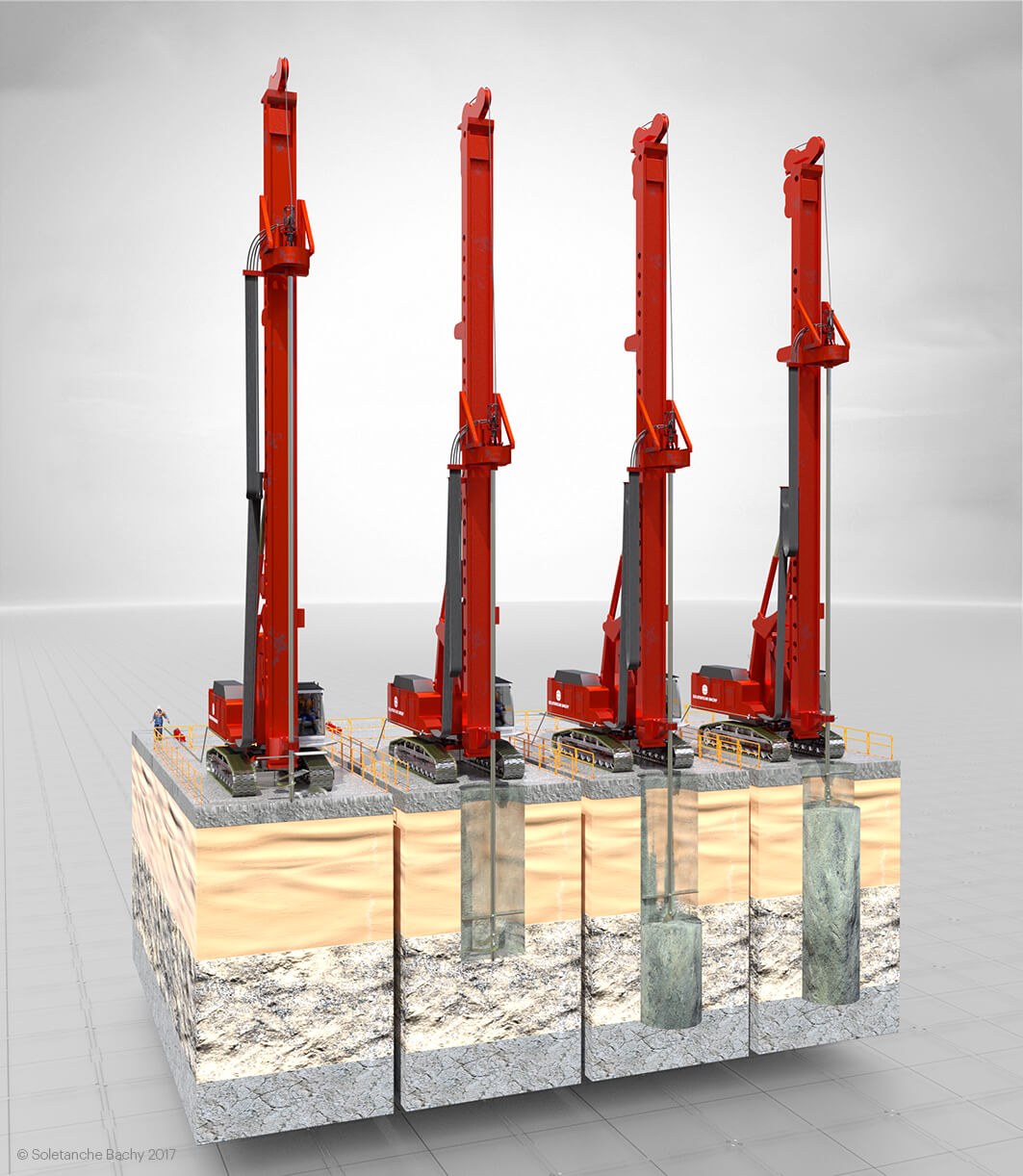
Deep Soil Mixing
A multi-application technique
Soletanche Bachy offers you its full range of Deep Soil Mixing processes for ground improvement, cut-off walls applications or support of excavation.

The technique was created in the 1970s and 1980s in Japan and Scandinavia, initially to improve the bearing capacity of very soft clay soils. Bachy was a trailblazer in this field, introducing its Colmix® process into Western Europe as early as 1986. Since then, the Deep Soil Mixing technique has been extended to a wide range of soil types and applications.
In practice, this technique consists of mechanically mixing the in-situ soil while incorporating a cementitious material, which is usually made of one or several hydraulic binders such as cement, blast furnace slag, lime, fly ash, etc.
This technique encompasses several different processes:
- The Colmix® process, which enables the formation of columns using one or more vertical rotating tools with mixing blades and mounted on piling rigs
- The Geomix® process, which creates wall panels using a CSM (Cutter Soil Mixing) tool based on technology derived from the Hydrofraise® process
- The Trenchmix® process for constructing continuous walls using a trencher
- The Springsol® process uses a small-diameter auger to form small-diameter vertical, inclined or sub-horizontal columns. This process is particularly suitable for use in confined spaces or where working height is limited.
Deep Soil Mixing has many applications across a broad spectrum of construction projects, including:
- The improvement of compressible soils subject to distributed loads: industrial warehouses, storage areas and linear structures such as rail and motorway embankments
- The treatment of soils to mitigate the risk of liquefaction
- The construction of continuous cut-off walls on levees and dikes, or low-permeability enclosures to contain polluted areas
- The construction of temporary or permanent retaining structures in combination with vertical strengthening elements (steel beams, pipes and/or pre-cast piles)
- Consolidation of embankment/cut slopes using transverse shear walls
Generally speaking, this technique is appropriate for any soil type. The soil/binder mix is a semi-rigid material behaving halfway between natural soil and concrete, and offers improved mechanical and hydraulic properties compared to the original soil.
What are the benefits of this technique?
A durable, semi-rigid material with known mechanical and hydraulic properties
Produces very little spoil (reusable in some cases)
A considerably smaller carbon footprint
Lower production and logistics costs
Saves time spent on preparatory work
Soletanche Bachy’s advantages
- Expertise underpinned by many patents and dedicated machinery,
- Recognised expertise in cement grouts and drilling fluids,
- In-depth understanding of the full range of processes available, allowing to offer you the most effective solution for your project.
Implementation
All these processes usually involve three stages: mechanical destructuring of the existing soil, incorporation of the mix and homogenisation of the mixture. Very often, all three stages are carried out simultaneously.
The binder mixed with the soil is selected and designed to obtain the hydraulic and/or mechanical characteristics required by the project. Where the technique is used to remediate polluted ground, the binder can be chosen specially to neutralise the pollution.
Once combined, the soil-cement mixture forms either columns, wall panels or continuous trenches.
In addition to the standard checks applied to the binder used and the properties of the mixture in-situ, all our processes benefit from real-time computerised implementation monitoring.
Checking and monitoring procedures may vary depending on the process used for your project. To find out more about specific processes, please visit the Geomix®, Trenchmix®, Colmix® and Springsol® pages of our website.

Implementation checks and monitoring
Did you know?
Since 2005, we have installed more than 2 million m² of cut-off wall on dikes.
Soletanche Bachy is a world leader in foundations and soil technologies, operating in 60 countries via a network of 80 subsidiaries and branches. The Group delivers the full range of geotechnical processes and provides innovative, effective solutions as either a lead or specialist contractor for turnkey projects with a geotechnical focus or specialist works.
 Soletanche Freyssinet
Soletanche FreyssinetThis website uses cookies to ensure you get the best experience
Learn more